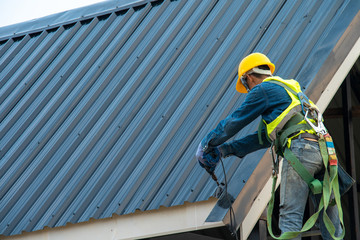If you’re considering roofing your home, it’s important to plan carefully and choose the right materials. You’ll also need to protect the items in your home and prepare for the installation process. This article provides you with tips and tricks for the roof installation process.

Getting a new roof can increase your home’s value. It also keeps the interior of your home protected from the elements. Some signs that you need a new roof include mold and deterioration of your home’s structure. But if you need clarification on your roofing needs, check with professionals.
Preparing for a new roof. The first step in preparing for a new roof is to check the quality of your current roof. If it’s old and damaged, you could be looking at a lot of work. A new roof will provide peace of mind for years to come.
There are many factors to consider when preparing for a new roof. From the materials to the cost, it’s important to know what you’re getting into. You’ll also need to keep an eye out for signs that you may need a new roof. As for materials, there are several options to choose from. Depending on the climate of your area, you might need to switch to more durable or aesthetically appealing materials.
Choosing the right materials. The material that you choose for your roof can drastically affect the look of your home. It can also affect its durability and cost. You want a strong enough roof to withstand Mother Nature’s elements for years.
Roof materials come in different styles and textures, and some are more attractive than others. Your roof should match the style and architecture of your home. In addition, you want to consider how often you plan to maintain it. Before you select the right material for your roof, consider the climate in your area. Some materials are better for colder or warmer climates. Materials that reflect sunlight can improve the energy efficiency of your home.
Asphalt shingles are the most popular choice. They are relatively inexpensive and easy to install. However, they can trap heat, and they are not the best choice for homes in areas where wildfires are a threat.
Metal roofs are an attractive option. They are durable and can last 30 to 50 years. Aluminum and steel shingles are a great choice, and metal roofing can be fabricated to look like traditional materials.
Drip edges are an important part of any roofing system. They help to prevent water from leaking under the shingles and into the fascia. This allows water to run off the roof and into gutters instead of rotting the fascia board or causing damage to the home.
Drip edges are an inexpensive way to add value to your home. However, it is essential to install them correctly. If not, you may end up with a leaky roof and structural problems in your attic. When installing a drip edge, start by removing any shingles from the lower portion of the roof. Then, cut the drip edge along a plumb line. Be careful not to cut too far.
Next, nail the drip edge to the ridge. Nails should be placed every 12 inches. In high wind areas, it is recommended that the nails be placed 4″ on center. Once the drip edge is installed, it is advisable to use an ice and water shield. This will help to protect your home from ice dams.
Protecting items from dust and debris. Roof replacements can produce a lot of dust and debris. You’ll need to protect your items, as well as other property, from the damage. There are several ways to prevent dust and debris from causing problems.
One way to ensure that you’re protected from construction dust is to install a dust and debris containment system. A good dust and debris containment system will collect lightweight particulates and keep them from escaping. It can also help prevent water infiltration during the tear-off process.
Before work begins, make sure you cover the floors of your home and the garage with protective sheets. If possible, you should move your car out of the driveway or parking area and into your garage. This will keep your vehicle from getting tangled in the construction site. Then, you can cover the doors and windows with drop cloths.
In addition, if you have a suspended ceiling, you’ll need to be careful when removing it. You can help protect your items by placing a plastic covering over the attic ceiling.